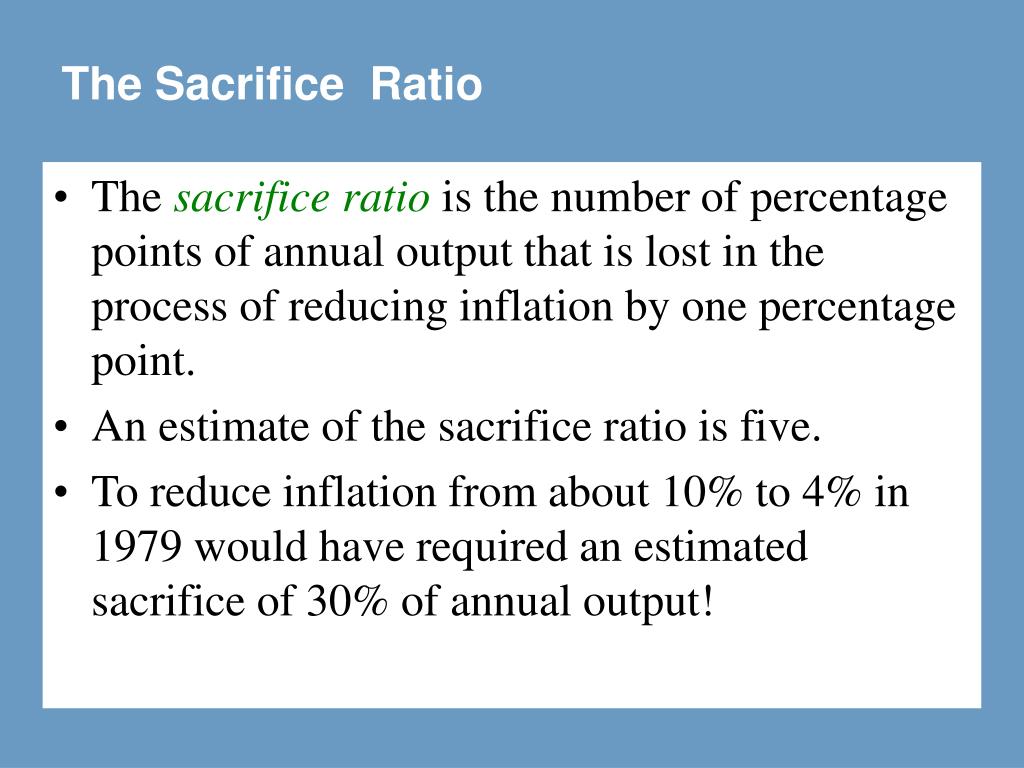Sacrificing Ratio Meaning, Example, Formula, etc

It measures the cost of reducing inflation by a certain percentage, in terms of the increase in unemployment required. For example, if a country wants to reduce inflation by 1%, the sacrifice ratio would indicate the percentage increase in unemployment necessary to achieve that goal. It is important to note that the optimal sacrifice ratio can vary across different economies.
How to Calculate Sacrificing Ratio
It is the ratio of cumulative percentage loss of GDP (due to disinflationary policy) to the reduction in inflation that is actually achieved. A – The sacrifice ratio assists the policymakers track the past monetary fluctuations and design a better fiscal policy accordingly. As needed, they can implement the steps required for boosting or reducing the economic pace. The SR depicts the sacrifice in terms of unemployment that monetary authorities have to make to pull down inflation. This sacrifice has to be made in the short run to reduce inflation expectations in the long run.
What is Sacrificing Ratio?
Therefore, to reach the desired 2% inflation rate, unemployment would need to increase by 9 percentage points. As with most calculations used to measure the condition of the economy, the sacrifice ratio is only as good as the data collected. Okun’s Law estimates the relationship between output and unemployment, and the short-run Phillips curve estimates the relationship between inflation and unemployment. The surge or reduction in SR is related to inflation rate fluctuations and approach to labor and product markets. While countries with more adaptable labor agreements, self-reliant central banks, stable rates, and reliable economic regulations possess a lower SR.
How to Beat Stagflation (with a case study)

After exploring the concept of sacrifice ratio and understanding the trade-off it presents between inflation and unemployment, it is crucial to determine the optimal sacrifice ratio for policymakers. This ratio holds significant importance as it directly affects the well-being of an economy and its citizens. In conclusion, the traditional trade-off between inflation and unemployment as depicted by the Phillips Curve is not the only lens through which policymakers can approach macroeconomic management. Alternative approaches, such as supply-side economics, wage flexibility, and unconventional monetary policies, offer different strategies for achieving a balance between these two variables. By considering these alternative approaches, policymakers can potentially find innovative solutions to the challenges of inflation and unemployment in today’s complex economic landscape.
- In the event that an economy is facing inflation, central banks have tools they can use to slow economic growth in a bid to reduce inflationary tensions.
- Since the ratio depicts the annual output an economy forgoes to reduce inflation, a low SR is always desirable.
- Monetary policy decisions made by central banks have a direct impact on the sacrifice ratio.
- According to this theory, allowing wages to adjust more freely in response to changes in supply and demand conditions can help maintain equilibrium in the labor market.
- When an individual enters the firm as a firm partner, it becomes mandatory to adopt a new profit sharing ratio.
The Relationship Between Inflation and Unemployment
On the other hand, the partner who gains the share calculates a gaining ratio at his/her end. While the sacrifice ratio is a widely used economic concept to understand the trade-off between inflation and unemployment, it is not without its critics and limitations. In this section, we will explore some of the main criticisms and limitations of the sacrifice ratio.
It seems that the economy may be facing a catastrophic recession of a magnitude not seen since the Great Depression of the 1930s may be on the horizon. Next, Using Okun’s law, we can estimate how much output will fall given a one percentage point increase in unemployment. The movement from point A to B depicts the sacrifice to be made to reduce inflation. When inflation expectations reduce in the long run, the Phillips curve PC2 is formed.
The sacrifice ratio shows how much output is lost when inflation goes down by 1%. This helps central banks to set their monetary policies, contingent upon whether they need to support or dial back the economy. For instance, if inflation is getting too high, the central bank can utilize the sacrifice ratio to determine what moves to make and at what level to influence output in the economy basically cost. The sacrifice ratio shows how much output is lost when inflation goes down by 1%.
During this period, the country faced high levels of inflation, reaching double digits. In an attempt to combat inflation, the Federal Reserve implemented contractionary monetary policies, resulting in a significant increase in unemployment. This experience highlighted the challenges policymakers face when trying to strike a balance between inflation and unemployment. sacrifice ratio formula An analysis of the ratio would show how the country might respond if the level of inflation changes by 1%. For example, if aggregate demand expands faster than aggregate supply in an economy, the result is higher inflation. If an economy is facing inflation, central banks have tools they can use to slow economic growth in a bid to reduce inflationary pressures.
One notable example of the sacrifice ratio in action is the Volcker disinflation in the United States during the early 1980s. To combat high inflation, then-Federal Reserve Chairman Paul Volcker implemented tight monetary policies, resulting in a significant increase in interest rates. This move led to a short-term rise in unemployment, but it successfully reduced inflation in the long run.

